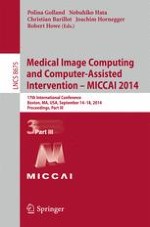2014 | Book
Medical Image Computing and Computer-Assisted Intervention – MICCAI 2014
17th International Conference, Boston, MA, USA, September 14-18, 2014, Proceedings, Part III
Editors: Polina Golland, Nobuhiko Hata, Christian Barillot, Joachim Hornegger, Robert Howe
Publisher: Springer International Publishing
Book Series : Lecture Notes in Computer Science
